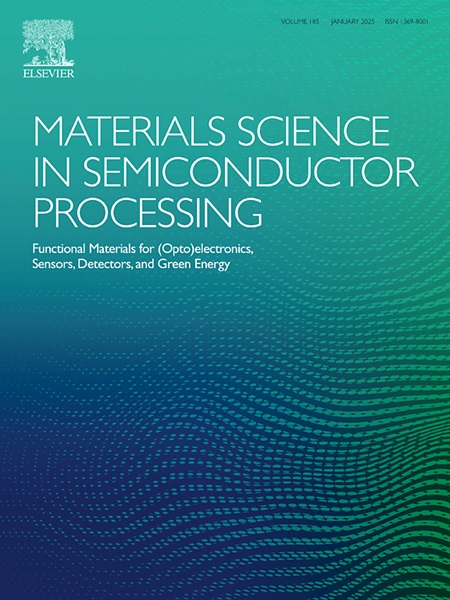基于纳米压痕和分子动力学的掺al p型4H-SiC基面位错成核研究
IF 4.6
3区 工程技术
Q2 ENGINEERING, ELECTRICAL & ELECTRONIC
引用次数: 0
摘要
高质量的p型4H-SiC晶体是超高压电源器件中必不可少的n沟道SiC绝缘栅双极晶体管的基础材料。然而,晶体缺陷,特别是位错阻碍了p型4H-SiC的发展。在所有类型的位错中,基底面位错(BPD)是最常见的。本研究采用纳米压痕技术研究了p型4H-SiC中BPD的成核过程,并通过分子动力学模拟分析了Al掺杂对BPD成核过程的影响。纳米压痕实验表明,随着Al掺杂浓度的增加,p型4H-SiC更容易发生塑性变形。这种变形主要包括BPD的形成、层错和晶体学转变。分子动力学模拟进一步阐明了这些观察结果背后的机制,表明Al掺杂促进了BPD成核,并且在更大的Al掺杂浓度下发生率更高。本研究的一个关键发现是,p型4H-SiC中BPD的主要发生源于Si-Al键的形成,这与名义上未掺杂的4H-SiC中BPD成核过程中Si-Si键的形成不同。这种区别突出了Al掺杂对晶格内原子尺度相互作用和缺陷形成过程的影响。该研究促进了对p型4H-SiC中BPD行为的认识,为其工业应用提供了基础。本文章由计算机程序翻译,如有差异,请以英文原文为准。
Investigation of basal plane dislocation nucleation in Al-doped p-type 4H-SiC using nanoindentation and molecular dynamics
High-quality p-type 4H-SiC crystals serve as the fundamental material for n-channel SiC insulated gate bipolar transistors, which are essential for ultra-high voltage power devices. However, the development of p-type 4H-SiC is hindered by crystal defects, particularly dislocations. Among all types of dislocations, basal plane dislocation (BPD) is the most common. This study employs nanoindentation to investigate BPD nucleation in p-type 4H-SiC, supported by molecular dynamics simulations to analyse the stress-strain behaviour and the effect of aluminium (Al) doping. Nanoindentation experiments reveal that p-type 4H-SiC exhibits easier plastic deformation with the increase of Al doping concentration. This deformation primarily involves the formation of BPD, stacking faults, and crystallographic transformations. Molecular dynamics simulations further elucidate the mechanisms behind these observations, showing that Al doping facilitates BPD nucleation, with a higher incidence rate at greater Al doping concentrations. A key finding of this study is that the primary occurrence of BPD in p-type 4H-SiC stems from the formation of Si-Al bonds, which is distinct from the formation of Si-Si bonds during BPD nucleation in nominally undoped 4H-SiC. This distinction highlights the impact of Al doping on the atomic-scale interactions and defect formation processes within the crystal lattice. This study advances the understanding of BPD behaviour in p-type 4H-SiC and provides a foundation for its industrial applications.
求助全文
通过发布文献求助,成功后即可免费获取论文全文。
去求助
来源期刊

Materials Science in Semiconductor Processing
工程技术-材料科学:综合
CiteScore
8.00
自引率
4.90%
发文量
780
审稿时长
42 days
期刊介绍:
Materials Science in Semiconductor Processing provides a unique forum for the discussion of novel processing, applications and theoretical studies of functional materials and devices for (opto)electronics, sensors, detectors, biotechnology and green energy.
Each issue will aim to provide a snapshot of current insights, new achievements, breakthroughs and future trends in such diverse fields as microelectronics, energy conversion and storage, communications, biotechnology, (photo)catalysis, nano- and thin-film technology, hybrid and composite materials, chemical processing, vapor-phase deposition, device fabrication, and modelling, which are the backbone of advanced semiconductor processing and applications.
Coverage will include: advanced lithography for submicron devices; etching and related topics; ion implantation; damage evolution and related issues; plasma and thermal CVD; rapid thermal processing; advanced metallization and interconnect schemes; thin dielectric layers, oxidation; sol-gel processing; chemical bath and (electro)chemical deposition; compound semiconductor processing; new non-oxide materials and their applications; (macro)molecular and hybrid materials; molecular dynamics, ab-initio methods, Monte Carlo, etc.; new materials and processes for discrete and integrated circuits; magnetic materials and spintronics; heterostructures and quantum devices; engineering of the electrical and optical properties of semiconductors; crystal growth mechanisms; reliability, defect density, intrinsic impurities and defects.
 求助内容:
求助内容: 应助结果提醒方式:
应助结果提醒方式:


